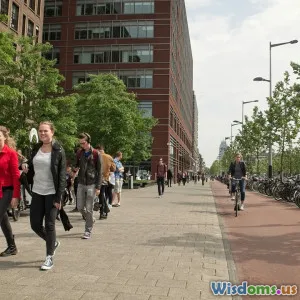
The Role of Biking in Urban Sustainability
9 min read Explore how biking promotes urban sustainability, reducing pollution and enhancing community engagement. (0 Reviews)
The Role of Biking in Urban Sustainability
Introduction
In an age when climate change threatens ecosystems and urban environments, innovative solutions are pivotal in creating sustainable cities. One of the most effective yet often overlooked aspects of urban sustainability is biking. As cities expand and traffic congestion worsens, the bike emerges as not just a mode of transportation but a lifeline to sustainability. According to the World Health Organization, biking can drastically cut urban transport emissions by up to 30%—a significant stride towards reducing greenhouse gases. In this article, we will delve into the role biking plays in urban sustainability, exploring the environmental, social, and economic implications it harbors. Preparation meets inspiration; read on to journey through the gears of urban change!
The Environmental Impact of Biking
Reducing Carbon Footprint
Biking effectively contributes to reducing urban carbon footprints. For instance, the City of Copenhagen has committed to becoming carbon neutral by 2025, heavily investing in cycling infrastructure, which currently accommodates over 62% of residents’ daily commutes by bike. This significant shift showcases Denmark’s focus on prioritizing alternative transportation and achieving long-term sustainability goals. Commuting by bike, instead of in gas-powered vehicles, negates fuel emissions. A 2017 study published in the journal Environmental Science & Technology indicated that, on average, commuting by bike emits a tenth of the pollution compared to commuting by car.
Promoting Clean Air and Smarter Cities
With bikes taking to the streets, cities experience tangible benefits, such as cleaner air and quieter environments. To illustrate this point, consider Portland, Oregon, which documented a reduction of approximately 2% in air pollution correlated with a 10% increase in bike ridership. As people bicycle more, vehicles occupy less space and roads, which aids in reducing the need for extensive parking lots and misplaced land use in urban planning that contribute to poor air quality.
Health Benefits of Biking
A Boost to Public Health
Biking is not solely a means to protect the environment; it is also a pathway to improving public health. The American Heart Association cites cycling as an effective cardiovascular exercise that lessens the risks of obesity, heart disease, and diabetes. Increased participation in cycling translates to healthier populations. A case study conducted by New York City after the introduction of its bike-sharing program, Citi Bike, reported over 20% of users had engaged in lifting their fitness levels since biking. This can minimize healthcare costs and support efficient urban planning that leads to healthier cities.
Impact on Mental Health
The positive implications of biking extend to mental health as well. Research indicates that biking can alleviate symptoms of anxiety and depression through the release of endorphins and engaging with nature. Moreover, studies affirm that a simple bike ride can elevate mood and energy levels, fostering community connections. The National Institute of Health promotes cycling as not only beneficial for physical health but a contributor to improving social interactions and encouraging a sense of belonging—the essence of thriving urban communities.
Economic Benefits of Biking
Cost-Effective Transportation
As cities commit to sustainability, biking presents a cost-efficient alternative to traditional transport. Vehicle ownership entails expenses such as buying, maintaining, insuring, and fueling, while biking drastically lowers these costs. A report from the League of American Bicyclists states that an average person who relies on biking for commuting rather than driving can potentially save over $3,000 annually on transportation costs.
Stimulating Local Economy
Biking is also one of the key players in revitalizing local economies. Studies from various urban centers across the USA reveal that businesses located on or near bike paths experience increased visitation rates. For example, Portland’s increasing cycling infrastructure linked cycling routes to more than $400 million in economic benefit, emphasizing not only how urban design centered around biking enhances economic vitality but also how community health mirrors local business success.
The Role of Infrastructure in Promoting Biking
Creating Bike-Friendly Cities
The transition towards sustainable urban environments relies heavily on developing supportive infrastructure for biking. High-quality and safe biking paths encourage residents to opt for biking as a viable transportation alternative. Cities like Amsterdam have long understood this; in fact, it boasts an impressive network of more than 500 km of bike paths, which seamlessly integrate into the overall transport system. In comparison, U.S. cities are gradually adopting similar initiatives—Atlanta recently invested in over 100 miles of bike lane extensions, showcasing the necessary investment in infrastructure for the growth of urban biking culture.
Policies and Community Engagement
Policies that foster cycling can be transformative. Cities that embrace bike-sharing programs, designated bike lanes, and provide necessary amenities such as bike racks encourage a sustainable future. Los Angeles launched its “GoLA” program, aimed at improving bike access within the city through workshops, community events, and public outreach, reiterating the importance of community engagement in fostering biking culture.
Challenges to Overcome
Cultural Perceptions and Safety Concerns
While biking fosters sustainability across various fronts, significant challenges hinder its widespread adoption. Cultural perceptions that stigmatize cycling as a less prestigious transportation form contribute to slow adoption rates. Furthermore, perceived safety risks hinder many from cycling in busy areas, meriting a collaborative approach to educating the public on bike-share systems and reinforcing safe biking practices.
Infrastructure Disparities
Additionally, urban areas grappling with infrastructural disparities find it more challenging to promote biking. Regions neglected in urban investment often see significantly less cycling due to a lack of safe bike lanes and secured bike parking. To mitigate these issues, it is vital to engage diverse stakeholders, including city planners, local government, and community members, in designing equitable biking infrastructure. Cities like San Francisco work towards solutions by investing in areas often overlooked to ensure biking as a viable transport option is available for all.
Conclusion
Biking plays a fundamental role in urban sustainability as a multifaceted solution to climate, health, and economic challenges on the rise in many metropolitan areas. By shifting perspectives and reshaping infrastructure, cities can transit towards a greener tomorrow. Reinforcing the connection between biking and sustainable urban practices offers a reclamation of urban spaces that cater to the environment, community, and economy. As we navigate these major shifts, the bike symbolizes not just transport but a shared commitment to paving pathways toward a sustainable future. Let us hitch our rides to this advent and champion a biking culture that sustains cities amid the ongoing climatic discourse and furnishes an actionable blueprint for the cities of tomorrow.
Rate the Post
User Reviews
Popular Posts





















